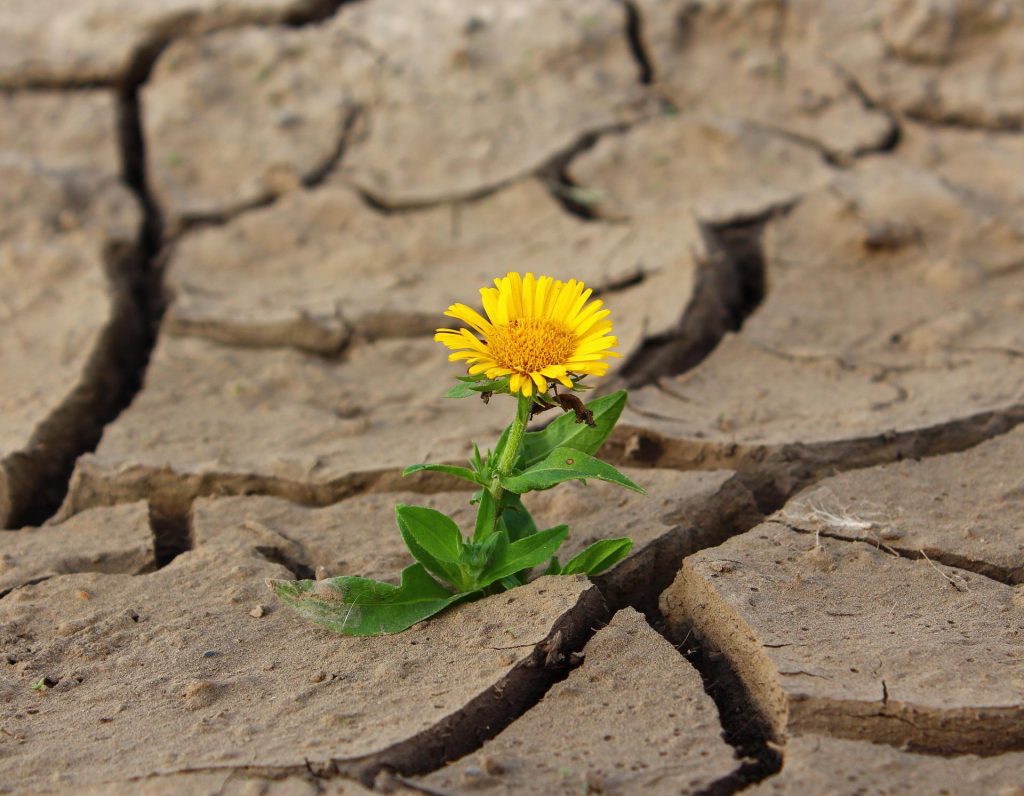
A current problem
For some time now, news are showing images of a country that we could have hardly predicted: dried rivers, empty fountains in the cities, and sadly dried crop fields. Agriculture is the sector that likely suffered the most from the concurrent raise in temperature and diminished rainfall. Nearly 40% of the Italian cropping area has been experiencing severe or extreme drought for more than a year, even in the most productive areas, including the Po Valley. Yield losses are estimated in 30-40% for fruits and summer vegetables and in up to 50% for maize and soybean.
To understand the reason of such a dramatic impact on agricultural production we can start from a simple question: how much water is actually needed to produce fruits, vegetables and grains that we eat every day? Exaggerated as it might seem, it takes around 13 litres of water to make a single tomato, 25 litres for a potato, over 55 litres for an apple and up to 350 litres for a plate of rice. Not surprisingly, agriculture is by far the largest consumer of water, absorbing nearly 60% of water withdrawals nationwide.
In light of the ongoing climate change and of the expected contraction of water resources, reducing water use in agriculture is a necessary and urgent need. Achieving such an important and complex goal requires, on the one hand, strategic programs at the national level, fostering a more rational water management, including the adoption of more efficient irrigation systems, as indicated in the National Rural Development Plan 2014-2022 (MIPAAF). On the other hand, the selection and cultivation of new resilient crop varieties is a key issue in developing a more sustainable agriculture.
Genetic has always played a relevant role in promoting innovation in agriculture. Over the past 20 years, genetic improvement of corps has led to a steady increase in yield, saving more than 21 million hectares pf land for agriculture in Europe alone. The actual challenge is selecting plants with reduced water needs and sustained yield under adverse environmental conditions.
Water-saving plants?
Considering their water balance, plants in general, and cultivate varieties in particular, are extremely inefficient systems. Over 90% of the water absorbed by roots is lost to the atmosphere as water vapour, in a process known as transpiration. Such a large amount of water loss results in reduced water use efficiency, defined as unit of product (e.g. kg of grain) per unit of water absorbed.
Transpiration essentially occurs through stomata; microscopic pores located on the leaf surface and formed by pairs of highly specialized guard cells (Figure 1A and B). Under optimal growth conditions, stomata remain open to maximise the input of CO2 for photosynthesis. Under water shortage, the rapid closure of stomatal pores represents a first line of defence, aimed at limiting excessive water loss and protecting the underlying tissues form dehydration.
Is it possible reprogramming stomatal activity to reduce water consumption and to increase drought tolerance? To address this question we started “hunting” for genes involved in the regulation of stomatal opening and closure. Using bioinformatics and genetics, we identified several candidate leads in the model plant Arabidopsis thaliana. Among these, the gene named AtMYB60 is of particular interest for two main features: (i) it is specifically expressed in stomata and, (ii) its expression in stomata is activated under optimal growth conditions, while it is rapidly suppressed under stress conditions.
To verify the potential of AtMYB60 as regulator of stomatal movements, we inactivated its function in Arabidopsis mutant lines. Interestingly we discovered that the loss of the AtMYB60 function results in the reduction of stomatal opening. By virtue of the stomata-specific expression of AtMYB60, the mutated plants did not show any alteration in other physiological or developmental process. Although the difference between plants with an active or inactivated AtMYB60 are limited to decreased stomatal opening, the consequences at the physiological level are surprising remarkable. Compared with control plants, lines mutated in AtMYB60 require a reduced amount of water to grow and can withstand prolonged period of water shortage. In other terms, the simple inactivation of this gene results in a more efficient water use and enhanced drought resistance.
It is important to note that we obtained these promising results in a model plant, of no agricultural interest, and under controlled laboratory conditions. How can we transfer these results to crops, cultivated in open fields? There are several bioinformatics and technological tools, which can assist the transition from model plant to crops. The complete genome sequence of most cultivate plants is nowadays available. These allowed the rapid identification of the equivalent (gene orthologue) of AtMYB60 in different crops. With the tools of molecular genetics, we verified that different orthologues from tomato, tobacco and grape behave exactly as the Arabidopsis gene.
Currently our effort are devoted to inactivate the tomato and grape MYB60 orthologues by means of state of the art genome editing techniques. Our aim is to select new genotypes with reduced stomatal opening and, consequently, with reduced transpirational water loss. The dream driving our activities? Developing new crop varieties with a smarter use of water to cope with the impact of climate change and reduced water availability in agriculture.
Author: Massimo Galbiati